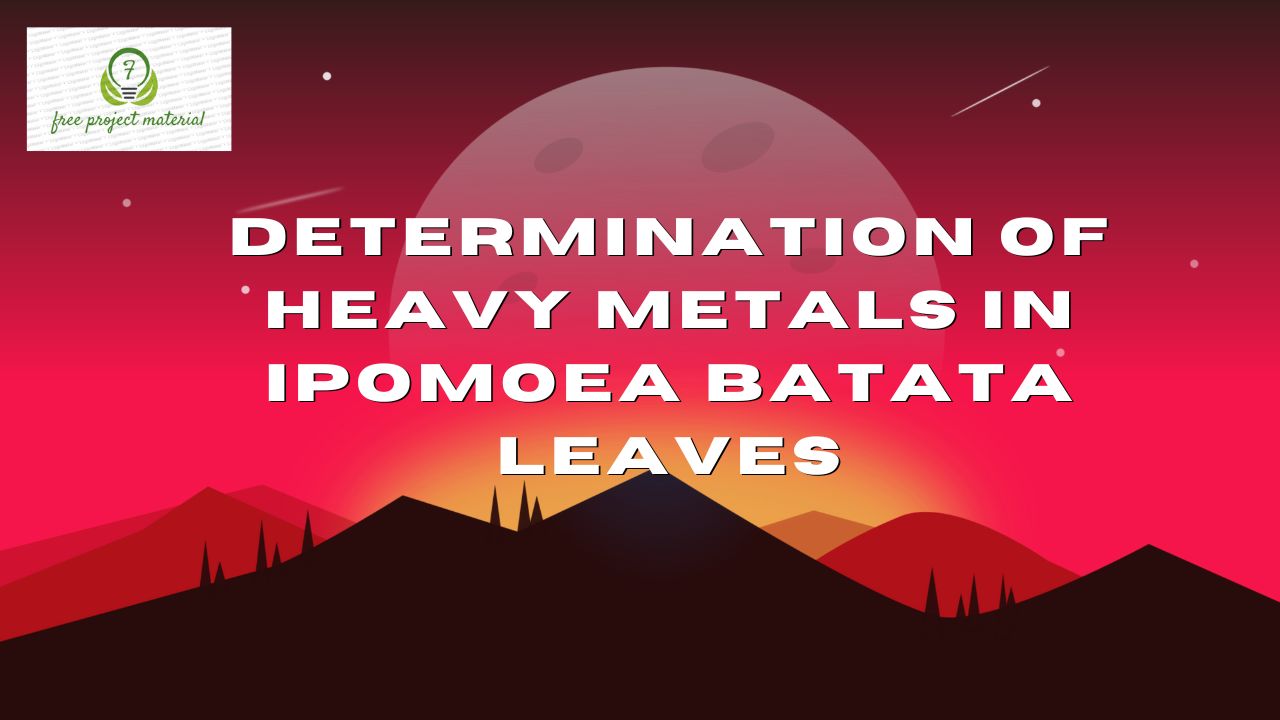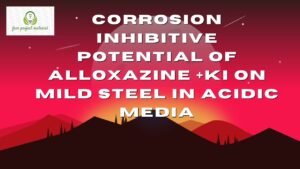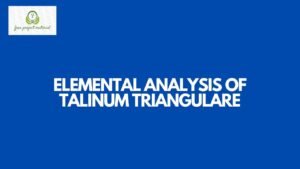ABSTRACT
The Ipomoea batata was collected from a farm in Abiakpo Ikot Essien, Ikot Ekpene Local Government Area. Standard analytical method were used in carrying out the analysis. The result of the analysis revealed the following: Pb (0.018±0.001 mg/100g), Cr (0.011±0.004 mg/100g), Cd (0.044±0.004 mg/100g), As (0.0095±0.0005 mg/100g), Hg (<0.001±0.000 mg/100g). This result identifies and implies that Ipomoea batata leave is good for consumption and should be added to our meal.
TABLE OF CONTENTS
Title Page- – – – – – – – – – i
Certification- – – – – – – – – ii
Dedication- – – – – – – – – – iii
Acknowledgements- – – – – – – – iv
Abstract- – – – – – – – – – v
Table of Content- – – – – – – – – vi-vii
CHAPTER ONE
1.0 INTRODUCTION
1.1 Background of the Study- – – – – – 1-5
1.2 Aim and Objectives of the Study- – – – – 5
1.3 Scope and Limitation of the Study- – – – – 5-6
1.4 Definition of terms- – – – – – – 6
CHAPTER TWO
2.0 LITERATURE REVIEW
2.1 Sources and Emission of Heavy Metal Metals- – – 7-8
2.2 Modes of Exposure to Heavy Metals- – – – – 9-12
2.3 Health Effect of Heavy Metal In Human- – – – 12
2.3.1 Arsenic- – – – – – – – – 12-14
2.3.2 Cadmium- – – – – – – – – 14-16
2.3.3 Lead – – – – – – – – – 17-18
2.3.4 Mercury- – – – – – – – – 18-20
2.4 Nutritional Value of Ipomoea batatas Leaves- – – 21-23
2.5 Physiological Function of Ipomoea batatas
Leaves and its Components- – – – – – 23
2.5.1 Antioxidative and Radical Scavenging Activity- – – 23-24
2.5.2 Antimutagenicity and Anticarcinogenicity- – – – 24-25
2.5.3 Antidiabetes- – – – – – – – 25-26
2.5.4 Anti-bacterial Activity – – – – – – – 26-27
CHAPTER THREE
3.0 MATERIALS AND METHODS
3.1 Materials and Reagents- – – – – – – 28-29
3.2 Sample Collection and Preparation- – – – – 29
3.3 Digestion of sample for heavy metals analysis – – 29-30
3.4 Analysis of Heavy Metals Contents- – – – – 30-31
CHAPTER FOUR
4.0 RESULTS AND DISCUSSION
4.1 Results- – – – – – – – – 32
4.2 Discussion- – – – – – – – – 33-36
CHAPTER FIVE
5.0 CONCLUSION AND RECOMMENDATIONS
5.1 Conclusion- – – – – – – – – 37
5.2 Recommendations- – – – – – – 37
References
CHAPTER ONE
1.0 INTRODUCTION
1.1 Background of the Study
Concentrations of several toxic metal and metalloids have been largely increased as a result of human activities. They can disturb important biochemical processes, constituting an important threat for the health of plant and animals. Plants and animals absorb these elements from soils, sediments, and water by contact with their external surfaces, through ingestion and also from inhalation of airborne particles and vaporized metals (Mudgal et al., 2010). The requirement for ingestion of trace metals such as Fe and Cu ions to maintain normal body functions such as the synthesis of metallo-proteins is well established. However, cases of excess intake of trace metal ions are credited with pathological events such as the deposition of iron oxides in Parkinson’s disease (Cetina et al., 2006). In addition to aiding neurological depositions, these redox active metals ions have been credited with enhancing oxidative damage, a key component of chronic inflammatory disease (Umanzor et al., 2006) and a suggested initiator of cancer (Elst et al., 2007). As inflammation is a characteristic feature of a wide range of diseases, further potential pathological roles for metal ions are emerging as exemplified by premature ageing (Carbello et al., 2008).
For the maintenance of health, a great deal of preventative measures is in place to avoid ingestion of potentially toxic metal ions. From monitoring endogenous levels of metal ions in foods and drinks to detecting contamination during food preparation, European countries spend significant resources to avoid metal intake by the general population (Hida et al., 2002). From a therapeutic viewpoint, considerable research and development efforts are being exerted to discorporate metal ions from the body. Since the use of As in World War I, researchers have advanced methods to discorporate toxic metals ions (Piazza et al., 2009). More recently efforts have moved to eradicate neurological deposits and reverse redox active metal ion contributions to oxidative stress. The latter approach has a focus on chelators that reverse the potential detrimental effects by generating anti-oxidant enzyme mimetics upon chelating the labile redox-active metal ion. Intriguingly, some very good candidates for anti oxidant prodrug chelators are common food constituents such as catechins (Aggarwal and Shishodia, 2006).
The sweetpotato (Ipomoea batatas Lam.) is the 7th most important food crop in the world (FAO 1997) and is among the crops selected by the U. S. Natl. Aeronautics and Space Administration to be grown in a controlled ecological life-support system as a primary food source (Hoff et al., 1982). Ipomoea batatas cultivars whose roots are used for a beverage, a paste, a powder, an alcohol drink, and a natural colorant have been developed in this decade (Yoshimoto 2001; Islam and Jalaluddin 2004).
However, Ipomoea batatas leaves have largely been neglected except for partial use as livestock feed. Utilization of Ipomoea batatas leaves as a vegetable could significantly increase food availability in countries with recurring food shortages. Ipomoea batatas greens are consumed to a limited extent as a fresh vegetable in some parts of the world (Villareal et al., 1982; Nwinyi 1992). Faced with increasing food shortages, agriculturists and food scientists are becoming increasingly interested in previously neglected tropical green leafy vegetables such as Ipomoea batatas greens. Low yield is a common deficit for tropical greens. However, the Ipomoea batatas can be harvested several times during the year, thus yielding substantially more than other greens. In addition, it is 1 of the few vegetables that can be grown during the monsoon season of the tropics, often making Ipomoea batatas leaves the only greens available in some countries after a flood or a typhoon. Ipomoea batatas leaves are rich in vitamin B, -carotene, iron, calcium, zinc, and protein; and as a crop, Ipomoea batatas is more tolerant of diseases, pests, and high moisture than many other leafy vegetables grown in the tropics (AVRDC 1985; Pace et al., 1985; Woolfe 1992; Ishiguro et al., 2002, 2004; Yoshimoto et al., 2003). Functional food products are aimed at introducing human dietary ingredients that aid specific bodily functions in addition to being nutritious. Several authors report that Ipomoea batata leaves are an excellent source of antioxidative polyphenolics, among them anthocyanins and phenolic acids such as caffeic, monocafeoyl quinic (chlorogenic), dicaffeoylquinic, and tricaffeoylquinic acids (Islam et al., 2002a, 2002b, 2003c), and are superior in this regard to other commercial vegetables (Ishiguro et al., 2002, 2004; Islam et al., 2002a, 2002b, 2002c, 2003b, 2003c; Yoshimoto et al., 2002a, 2003). The nutritional attributes of Ipomoea batatas leaves are increasingly recognized, as a better understanding emerges in the relationship between diet and human health.
1.2 Aim and Objectives of the Study
This study is aimed at determining the heavy metal composition of Ipomoea batatas leaves.
The specific objectives of the study are as follows:
- Determine the Heavy metal composition (e.g Cd, Pb, Hg, As) of Ipomoea batatas leaves
- To compare with the standard permissible limit
- To make useful recommendation based on the result of the findings
1.3 Scope and Limitation of the Study
This study covers only the determination of heavy metal composition of sweet Ipomoea batatas leaves cultivated in Ikot Ekpene. The limitation encountered in the course of this study were, financial constraint and time constraints.
1.4 Definition of terms
Heavy metals: Is the metallic chemical element that has a relatively high density and is toxic or poisonous at low concentration.
Enzymes: They are proteins that helps speed up metabolism, or the chemical reactions in our bodies.
Phenolic: A usually thermosetting resin or plastic made by condensation of a phenol with an aldehyde and used especially for molding and insulating and in coatings and adhesives.



